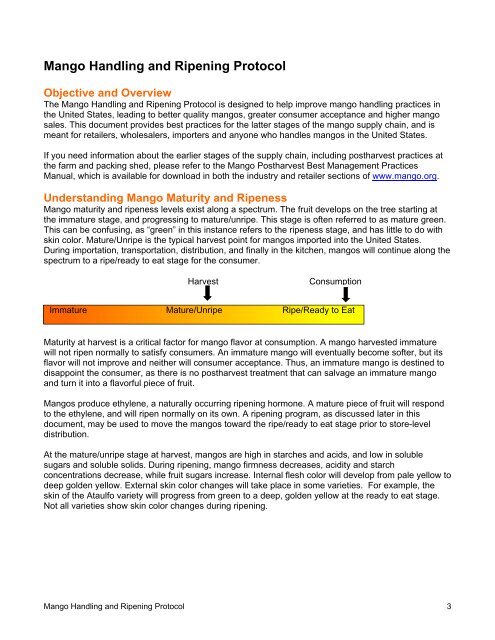Mango Handling and Ripening Protocol
Mango_Handling_and_Ripening_Protocol
Mango_Handling_and_Ripening_Protocol
- No tags were found...
Create successful ePaper yourself
Turn your PDF publications into a flip-book with our unique Google optimized e-Paper software.
<strong>Mango</strong> <strong>H<strong>and</strong>ling</strong> <strong>and</strong> <strong>Ripening</strong> <strong>Protocol</strong><br />
Objective <strong>and</strong> Overview<br />
The <strong>Mango</strong> <strong>H<strong>and</strong>ling</strong> <strong>and</strong> <strong>Ripening</strong> <strong>Protocol</strong> is designed to help improve mango h<strong>and</strong>ling practices in<br />
the United States, leading to better quality mangos, greater consumer acceptance <strong>and</strong> higher mango<br />
sales. This document provides best practices for the latter stages of the mango supply chain, <strong>and</strong> is<br />
meant for retailers, wholesalers, importers <strong>and</strong> anyone who h<strong>and</strong>les mangos in the United States.<br />
If you need information about the earlier stages of the supply chain, including postharvest practices at<br />
the farm <strong>and</strong> packing shed, please refer to the <strong>Mango</strong> Postharvest Best Management Practices<br />
Manual, which is available for download in both the industry <strong>and</strong> retailer sections of www.mango.org.<br />
Underst<strong>and</strong>ing <strong>Mango</strong> Maturity <strong>and</strong> Ripeness<br />
<strong>Mango</strong> maturity <strong>and</strong> ripeness levels exist along a spectrum. The fruit develops on the tree starting at<br />
the immature stage, <strong>and</strong> progressing to mature/unripe. This stage is often referred to as mature green.<br />
This can be confusing, as “green” in this instance refers to the ripeness stage, <strong>and</strong> has little to do with<br />
skin color. Mature/Unripe is the typical harvest point for mangos imported into the United States.<br />
During importation, transportation, distribution, <strong>and</strong> finally in the kitchen, mangos will continue along the<br />
spectrum to a ripe/ready to eat stage for the consumer.<br />
Harvest Consumption<br />
Immature Mature/Unripe Ripe/Ready to Eat<br />
Maturity at harvest is a critical factor for mango flavor at consumption. A mango harvested immature<br />
will not ripen normally to satisfy consumers. An immature mango will eventually become softer, but its<br />
flavor will not improve <strong>and</strong> neither will consumer acceptance. Thus, an immature mango is destined to<br />
disappoint the consumer, as there is no postharvest treatment that can salvage an immature mango<br />
<strong>and</strong> turn it into a flavorful piece of fruit.<br />
<strong>Mango</strong>s produce ethylene, a naturally occurring ripening hormone. A mature piece of fruit will respond<br />
to the ethylene, <strong>and</strong> will ripen normally on its own. A ripening program, as discussed later in this<br />
document, may be used to move the mangos toward the ripe/ready to eat stage prior to store-level<br />
distribution.<br />
At the mature/unripe stage at harvest, mangos are high in starches <strong>and</strong> acids, <strong>and</strong> low in soluble<br />
sugars <strong>and</strong> soluble solids. During ripening, mango firmness decreases, acidity <strong>and</strong> starch<br />
concentrations decrease, while fruit sugars increase. Internal flesh color will develop from pale yellow to<br />
deep golden yellow. External skin color changes will take place in some varieties. For example, the<br />
skin of the Ataulfo variety will progress from green to a deep, golden yellow at the ready to eat stage.<br />
Not all varieties show skin color changes during ripening.<br />
<strong>Mango</strong> <strong>H<strong>and</strong>ling</strong> <strong>and</strong> <strong>Ripening</strong> <strong>Protocol</strong> 3


